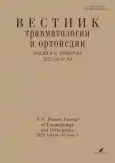Infrared thermography in the assessment of temporomandibular joint dysfunction against the background of biomechanical disorders of the cervical spine
- Authors: Novikov Y.O.1, Gerasimova L.P.1, Yantilina A.A.1, Yasinskaya A.S.1, Arslanova M.A.1
-
Affiliations:
- Bashkir State Medical University
- Issue: Vol 32, No 1 (2025)
- Pages: 119-126
- Section: Original study articles
- URL: https://journal-vniispk.ru/0869-8678/article/view/290972
- DOI: https://doi.org/10.17816/vto633953
- ID: 290972
Cite item
Abstract
BACKGROUND: The method of infrared medical thermography (IMT), despite its advantages, has not yet found active application in the diagnosis of temporomandibular joint dysfunction syndrome and biomechanical disorders of the cervical spine. This article presents the results of a thermographic examination that can be used in the diagnosis of temporomandibular joint dysfunction and biomechanical disorders of the cervical spine.
AIM: To evaluate the data of medical infrared thermography in temporomandibular joint dysfunction associated with biomechanical disorders of the cervical spine.
MATERIALS AND METHODS: The cross-sectional study included 60 patients who were divided into two groups — the main group (30 people) with the presence of temporomandibular joint dysfunction syndrome and the control group (30 people) without temporomandibular joint dysfunction. The groups underwent a detailed clinical and instrumental examination: clinical manifestations of temporomandibular joint dysfunction were evaluated, as well as imaging, thermal imaging, and electromyographic examination.
RESULTS: On IMT examination, diagnostically significant facial thermoasymmetry was found in 70% of patients in the main group and in 6.67% of patients in the control group. Posterior neck thermoasymmetry was detected in 80 and 26.7% of patients, respectively. According to MRI data, static and dystrophic changes of the cervical spine were detected in 73.3% of patients in the main group and 23.3% in the control group.
CONCLUSION: The study showed that IMT is highly informative in temporomandibular joint dysfunction syndrome, allowing early diagnosis and differential diagnosis of the disease.
Full Text
##article.viewOnOriginalSite##About the authors
Yuri O. Novikov
Bashkir State Medical University
Author for correspondence.
Email: profnovikov@yandex.ru
ORCID iD: 0000-0002-6282-7658
SPIN-code: 3412-6610
MD, Dr. Sci. (Medicine), professor
Russian Federation, 3 Lenina str., 450008 UfaLarisa P. Gerasimova
Bashkir State Medical University
Email: gerasimovalarisa@rambler.ru
ORCID iD: 0000-0002-1145-6500
SPIN-code: 1533-8640
MD, Dr. Sci. (Medicine), professor
Russian Federation, 3 Lenina str., 450008 UfaAnastasia A. Yantilina
Bashkir State Medical University
Email: yantilina.a@mail.ru
ORCID iD: 0009-0008-2434-906X
SPIN-code: 4508-0126
MD
Russian Federation, 3 Lenina str., 450008 UfaAnna S. Yasinskaya
Bashkir State Medical University
Email: nutta23@rambler.ru
ORCID iD: 0000-0003-3245-5918
SPIN-code: 3958-1396
MD, postgraduate student
Russian Federation, 3 Lenina str., 450008 UfaMaya A. Arslanova
Bashkir State Medical University
Email: may.ars00@mail.ru
ORCID iD: 0009-0004-7780-1751
student
Russian Federation, 3 Lenina str., 450008 UfaReferences
- Golovatenko OV, Shevkunova NA, Khusainov AI. An analysis of the occurrence of signs of temporomandibular disorders in young people. International research journal. 2021;113(11):140–142. (in Russ.) doi: 10.23670/IRJ.2021.113.11.060
- Valesan LF, Da-Cas CD, Réus JC, et al. Prevalence of temporomandibular joint disorders: a systematic review and meta-analysis. Clinical oral investigations. 2021;25(2):441–453. doi: 10.1007/s00784-020-03710-w
- Silva MAG, Pantoja LLQ, Dutra-Horstmann KL, et al. Prevalence of degenerative disease in temporomandibular disorder patients with disc displacement: A systematic review and meta-analysis. Journal of cranio-maxillo-facial surgery. 2020;48(10):942–955. doi: 10.1016/j.jcms.2020.08.004
- Prodoehl J, Thomas P, Krzak JJ, et al. Effect of Starting Posture on Three-Dimensional Jaw and Head Movement. J Oral Maxillofac Res. 2022;13(1):e4. doi: 10.5037/jomr.2022.13104
- de Oliveira-Souza AIS, de O Ferro JK, Barros MMMB, Oliveira DA. Cervical musculoskeletal disorders in patients with temporomandibular dysfunction: A systematic review and meta-analysis. J Bodyw Mov Ther. 2020;24(4):84–101. doi: 10.1016/j.jbmt.2020.05.001
- Hong SW, Lee JK, Kang JH. Relationship among Cervical Spine Degeneration, Head and Neck postures, and Myofascial Pain in Masticatory and Cervical Muscles in Elderly with Temporomandibular Disorder. Arch Gerontol Geriatr. 2019;81:119–128. doi: 10.1016/j.archger.2018.12.004
- Pilipovich AA. Neck pain: diagnostic and therapeutic features. Meditsinskiy sovet. 2021;(21–1):55–62. (In Russ.) EDN: XOBCYN
- Aliev NH. Innovative methods of assessment and diagnosis of temporomandibular joint dysfunction. Scientific journal of applied and medical sciences. 2024;3(5):737–744. (In Russ.)
- Novikov AYu, Novikov YuO. The use of medical infrared thermography in musculo-skeletal pain. Bashkortostan Medical Journal. 2019;14(4):100–103. (In Russ.) EDN: BVJAQJ
- Zhao Y, Jeroen Bergmann HM. Non-Contact Infrared Thermometers and Thermal Scanners for Human Body Temperature Monitoring: A Systematic Review. Sensors. 2023; 23(17):7439. doi: 10.3390/s23177439
- Albuquerque NF, Lopes BS. Musculoskeletal applications of infrared thermography on back and neck syndromes: a systematic review. Eur J Phys Rehabil Med. 2021;57 Suppl 3:386S–396S. doi: 10.23736/S1973-9087.20.06287-5
- Schiavon G, Capone G, Frize M, et al. Infrared Thermography for the Evaluation of Inflammatory and Degenerative Joint Diseases: A Systematic Review. Cartilage. 2021;13(2):1790–1801. doi: 10.1177/19476035211063862
- de Almeida ANS, de Souza Ferreira SL, Balata PMM, et al. Thermography in complementary assessments of head and neck muscles: A scoping review. J Oral Rehabil. 2022;49(12):1188–1196. doi: 10.1111/joor.13374
- Moreira A, Batista R, Oliveira S, et al. Role of thermography in the assessment of temporomandibular disorders and other musculoskeletal conditions: A systematic review. Proceedings of the Institution of Mechanical Engineers. Part H, Journal of engineering in medicine. 2021;235(10):1099–1112. doi: 10.1177/09544119211023616
- Machoy M, Szyszka-Sommerfeld L, Rahnama M, et al. Diagnosis of temporomandibular disorders using thermovision imaging. Pain Res Manag. 2020;2020:5481365. doi: 10.1155/2020/5481365
- Karamyshev YV, Dolgov IM, Zheleznyak IS, et al. Could we use digital infrared medical thermography to distinguish SARS-СоV-2 viral from community acquired pneumonia? Medical alphabet. 2023;(33):40–46. (In Russ.) doi: 10.33667/2078-5631-2022-33-40-46
- Rodrigues-Bigaton D, Dibai-Filho AV, Packer AC, et al. Accuracy of two forms of infrared image analysis of the masticatory muscles in the diagnosis of myogenous temporomandibular disorder. Journal of bodywork and movement therapies. 2014;18(1):49–55. doi: 10.1016/j.jbmt.2013.05.005
- Gerasimova LP, Yakupov BR. Study of the functional state of the actual chewing and temporal muscles of the temporomandibular joint in musculo-articular dysfunction associated with occlusive disorders using an electromyograph. Science in Central Russia. 2013;(4):178–181 (In Russ.) EDN: QARHWH
- Azimov A, Azimov M. Thermography of the face in healthy people. Zhurnal stomatologii i kraniofacial’nyh issledovanij. 2020;1(2):72–74. (in Russ.)
Supplementary files










